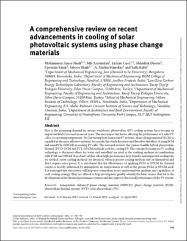A comprehensive review on recent advancements in cooling of solar photovoltaic systems using phase change materials

View/
Access
info:eu-repo/semantics/openAccessDate
2022Author
Sheik, Mohammed AneesAravindan, M. K.
Cüce, Erdem
Dasore, Abhishek
Rajak, Upendra
Shaik, Saboor
Manokar, A. Muthu
Riffat, Saffa
Metadata
Show full item recordCitation
Sheik, M.A., Aravindan, M.K., Cuce, E., Dasore, A., Rajak, U., Shaik, S., Manokar, A.M. & Riffat, S. (2022). A comprehensive review on recent advancements in cooling of solar photovoltaic systems using phase change materials. International Journal of Low-Carbon Technologies, 17, 768-783. https://doi.org/10.1093/ijlct/ctac053Abstract
Due to the increasing demand for energy worldwide, photovoltaic (PV) cooling systems have become an important field of research in recent years. The most important factor affecting the performance of a solar PV cell is its operating temperature. For harvesting heat from solar PV systems, phase change material (PCM) is regarded as the most effective material. As a result, this study discusses and describes the effect of using PCM and nanoPCM (NPCM) in cooling PV cells. This research reviews the various feasible hybrid photovoltaic thermal (PVT)-PCM and PVT-NPCM methods used for cooling PV. The concept focusing on PV cooling technology is discussed where air, water and nanofluid are used as the working medium in combination with PCM and NPCM. It is observed that when high performance heat transfer and improved cooling rate are needed, active cooling methods are favoured, whereas passive cooling methods rely on themselves and don't require extra power. It is also found that the effectiveness of applying PCM or NPCM for thermal control is heavily influenced by atmospheric air temperatures as well as the precise PCM or NPCM used. It is envisaged that this review will help new researchers better understand the qualities and capabilities of each cooling strategy. They are offered to help investigators quickly identify the basic science that led to the development of the thermal performance system and also improve the overall performance of the PV system.

















